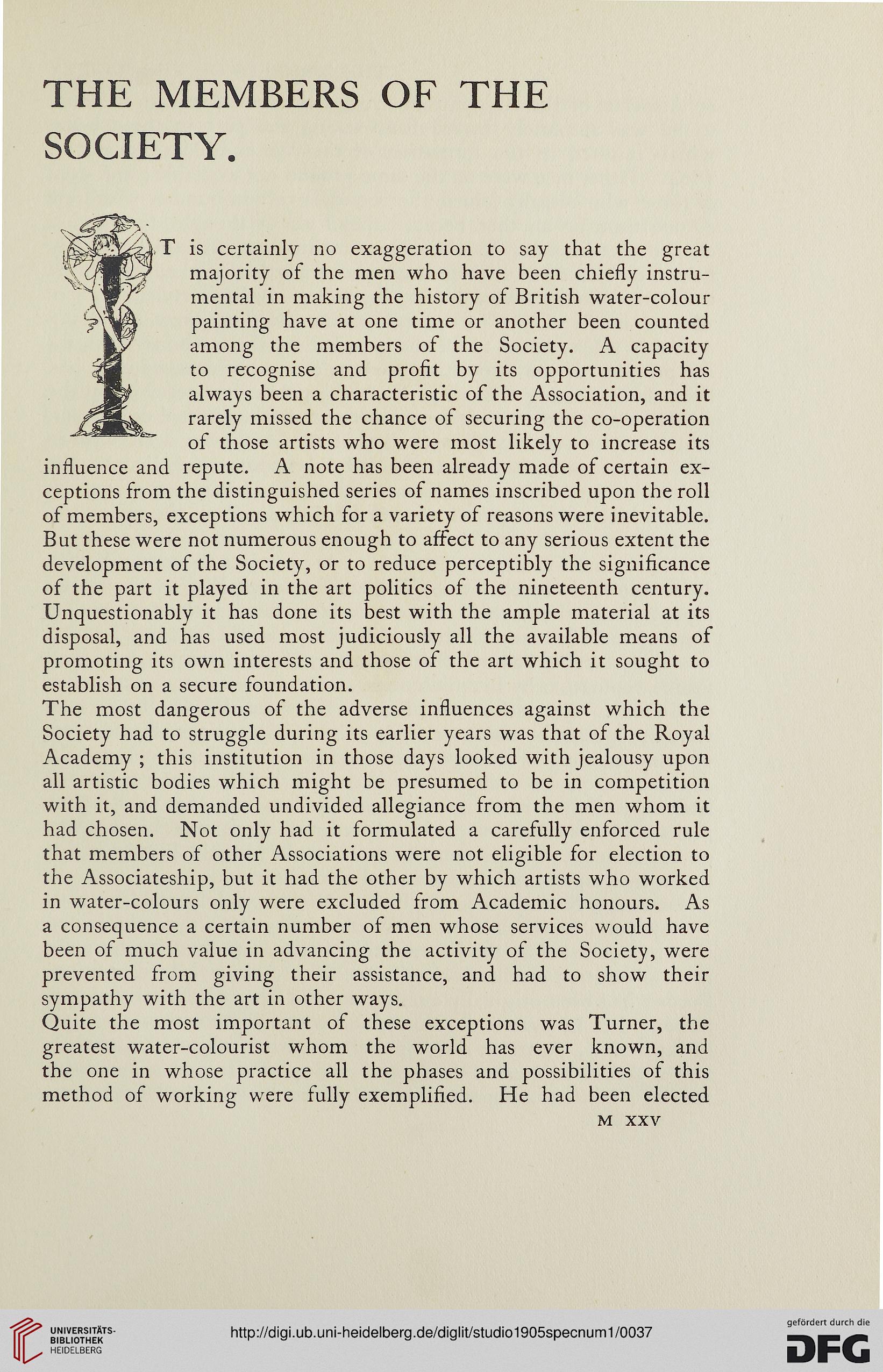THE MEMBERS OF THE
SOCIETY.
T is certainly no exaggeration to say that the great
majority of the men who have been chiefly instru-
mental in making the history of British water-colour
painting have at one time or another been counted
among the members of the Society. A capacity
to recognise and profit by its opportunities has
always been a characteristic of the Association, and it
rarely missed the chance of securing the co-operation
of those artists who were most likely to increase its
influence and repute. A note has been already made of certain ex-
ceptions from the distinguished series of names inscribed upon the roll
of members, exceptions which for a variety of reasons were inevitable.
But these were not numerous enough to affect to any serious extent the
development of the Society, or to reduce perceptibly the significance
of the part it played in the art politics of the nineteenth century.
Unquestionably it has done its best with the ample material at its
disposal, and has used most judiciously all the available means of
promoting its own interests and those of the art which it sought to
establish on a secure foundation.
The most dangerous of the adverse influences against which the
Society had to struggle during its earlier years was that of the Royal
Academy ; this institution in those days looked with jealousy upon
all artistic bodies which might be presumed to be in competition
with it, and demanded undivided allegiance from the men whom it
had chosen. Not only had it formulated a carefully enforced rule
that members of other Associations were not eligible for election to
the Associateship, but it had the other by which artists who worked
in water-colours only were excluded from Academic honours. As
a consequence a certain number of men whose services would have
been of much value in advancing the activity of the Society, were
prevented from giving their assistance, and had to show their
sympathy with the art in other ways.
Quite the most important of these exceptions was Turner, the
greatest water-colourist whom the world has ever known, and
the one in whose practice all the phases and possibilities of this
method of working were fully exemplified. He had been elected
m xxv
SOCIETY.
T is certainly no exaggeration to say that the great
majority of the men who have been chiefly instru-
mental in making the history of British water-colour
painting have at one time or another been counted
among the members of the Society. A capacity
to recognise and profit by its opportunities has
always been a characteristic of the Association, and it
rarely missed the chance of securing the co-operation
of those artists who were most likely to increase its
influence and repute. A note has been already made of certain ex-
ceptions from the distinguished series of names inscribed upon the roll
of members, exceptions which for a variety of reasons were inevitable.
But these were not numerous enough to affect to any serious extent the
development of the Society, or to reduce perceptibly the significance
of the part it played in the art politics of the nineteenth century.
Unquestionably it has done its best with the ample material at its
disposal, and has used most judiciously all the available means of
promoting its own interests and those of the art which it sought to
establish on a secure foundation.
The most dangerous of the adverse influences against which the
Society had to struggle during its earlier years was that of the Royal
Academy ; this institution in those days looked with jealousy upon
all artistic bodies which might be presumed to be in competition
with it, and demanded undivided allegiance from the men whom it
had chosen. Not only had it formulated a carefully enforced rule
that members of other Associations were not eligible for election to
the Associateship, but it had the other by which artists who worked
in water-colours only were excluded from Academic honours. As
a consequence a certain number of men whose services would have
been of much value in advancing the activity of the Society, were
prevented from giving their assistance, and had to show their
sympathy with the art in other ways.
Quite the most important of these exceptions was Turner, the
greatest water-colourist whom the world has ever known, and
the one in whose practice all the phases and possibilities of this
method of working were fully exemplified. He had been elected
m xxv




